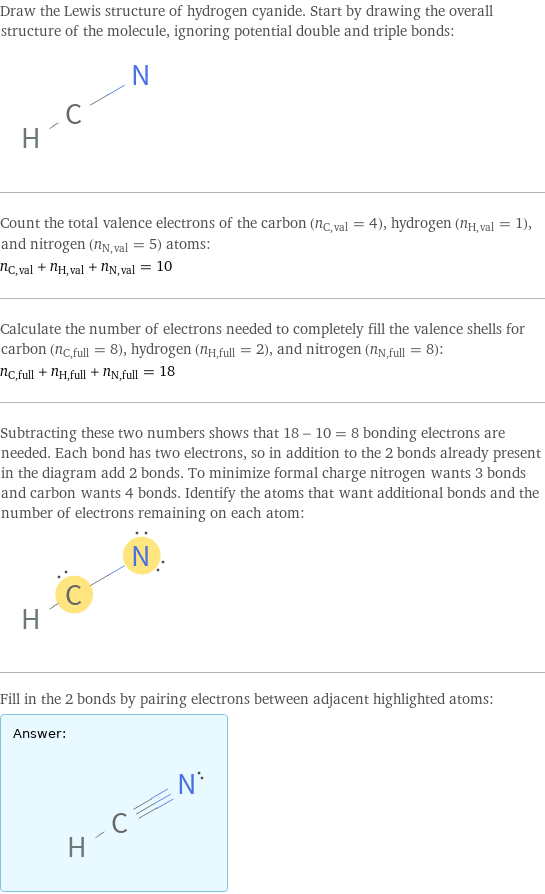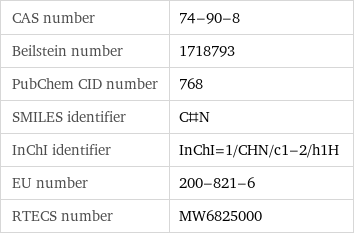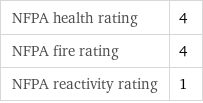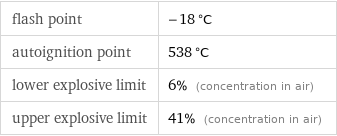Input interpretation

hydrogen cyanide
Chemical names and formulas

formula | HCN Hill formula | CHN name | hydrogen cyanide IUPAC name | formonitrile alternate names | blausaeure | formonitrile | hydrocyanic acid mass fractions | C (carbon) 44.4% | H (hydrogen) 3.73% | N (nitrogen) 51.8%
Lewis structure

Draw the Lewis structure of hydrogen cyanide. Start by drawing the overall structure of the molecule, ignoring potential double and triple bonds: Count the total valence electrons of the carbon (n_C, val = 4), hydrogen (n_H, val = 1), and nitrogen (n_N, val = 5) atoms: n_C, val + n_H, val + n_N, val = 10 Calculate the number of electrons needed to completely fill the valence shells for carbon (n_C, full = 8), hydrogen (n_H, full = 2), and nitrogen (n_N, full = 8): n_C, full + n_H, full + n_N, full = 18 Subtracting these two numbers shows that 18 - 10 = 8 bonding electrons are needed. Each bond has two electrons, so in addition to the 2 bonds already present in the diagram add 2 bonds. To minimize formal charge nitrogen wants 3 bonds and carbon wants 4 bonds. Identify the atoms that want additional bonds and the number of electrons remaining on each atom: Fill in the 2 bonds by pairing electrons between adjacent highlighted atoms: Answer: | |
3D structure

3D structure
Basic properties

molar mass | 27.026 g/mol phase | liquid (at STP) melting point | -13.4 °C boiling point | 25.6 °C density | 0.697 g/cm^3 solubility in water | miscible
Units

Liquid properties (at STP)

density | 0.697 g/cm^3 vapor pressure | 742 mmHg (at 25 °C) dynamic viscosity | 1.83×10^-4 Pa s (at 25 °C) surface tension | 0.0172 N/m refractive index | 1.00045
Units

Thermodynamic properties

specific heat capacity c_p | gas | 1.328 J/(g K) | liquid | 2.612 J/(g K) molar heat capacity c_p | gas | 35.9 J/(mol K) | liquid | 70.6 J/(mol K) specific free energy of formation Δ_fG° | gas | 4.614 kJ/g molar free energy of formation Δ_fG° | gas | 124.7 kJ/mol specific heat of formation Δ_fH° | gas | 4.999 kJ/g molar heat of formation Δ_fH° | gas | 135.1 kJ/mol specific entropy S° | gas | 7.474 J/(g K) molar entropy S° | gas | 202 J/(mol K) molar heat of vaporization | 25.2 kJ/mol | specific heat of vaporization | 0.932 kJ/g | molar heat of combustion | 664 kJ/mol | specific heat of combustion | 24.6 kJ/g | molar heat of fusion | 8.41 kJ/mol | specific heat of fusion | 0.311 kJ/g | critical temperature | 457 K | critical pressure | 5.394 MPa | (at STP)
Chemical identifiers

CAS number | 74-90-8 Beilstein number | 1718793 PubChem CID number | 768 SMILES identifier | C#N InChI identifier | InChI=1/CHN/c1-2/h1H EU number | 200-821-6 RTECS number | MW6825000
NFPA label

NFPA label

NFPA health rating | 4 NFPA fire rating | 4 NFPA reactivity rating | 1
Safety properties

flash point | -18 °C autoignition point | 538 °C lower explosive limit | 6% (concentration in air) upper explosive limit | 41% (concentration in air)

DOT hazard class | 6.1 DOT numbers | 1051
Toxicity properties

short-term exposure limit | 10 mg/m^3 threshold limit value | 4.7 ppmv

RTECS classes | agricultural chemical and pesticide | human data